High Speed Dissolving of Viscosity Index Improvers in Lube Oils
Lube oils, in common with most fluids, experience reduced viscosity at high operating temperatures. This results in a poorer hydrodynamic film and poorer lubrication. Heavier base oil can be used to overcome this, but problems arise with cold starting and pumping at low temperatures. Multigrade oils were developed to achieve the optimum viscosity across a full range of operating temperatures in those applications where it is required.
The Process
The problems of temperature/viscosity instability are solved in multigrade lube oils by the addition of Viscosity Index Improvers, made from various types of polymer, including:
- Polymethacrylates
- Styrene Butadiene copolymer
- Styrene Isoprene copolymer
- Ethylene Propylene copolymer
These provide a more stable viscosity and allow the formulation of oils with lower viscosity base oil (for easier cold starting) and yet which have adequate high temperature viscosity for engine protection.
VI improvers make up around 10% of the content of a typical multigrade lube oil, and increase the raw material costs of the finished product. Polymer is available in liquid, crumb, pellet and solid bale form. Each of these types has a different processing requirement:
Liquid Polymer
- Polymer may be predissolved by the supplier, and is supplied in liquid form. It is easy to use and requires no special mixing equipment or processing.
- The liquid polymer is weighed/metered into heated base oil and blended by simple agitation.
Crumb & Pellet
- Polymer supplied in pellet or crumb form is added directly to the heated base oil.
- Good in-tank agitation is required to disperse the polymer, and to maintain vigorous movement within the vessel.
- The hot oil penetrates the polymer, which softens and gradually becomes solubilized into the oil.
Solid Bales
- The bales of polymer are shredded, chopped or granulated into small pieces before addition to the base oil.
- The polymer is added to the oil and dispersed by the agitator.
- Mixing is continued for several hours to allow the polymer to become solubilized.
- Good in-tank agitation is required to disperse the polymer, and maintain vigorous movement within the vessel.
The Problem
Liquid Polymer
- This is the most expensive form of polymer.
- Polymer is predispersed into base oil in bulk by the polymer supplier, leading to additional costs in respect of the base oil itself and the costs of processing and bulk transport.
Crumb & Pellet
- With conventional agitation, many hours are required to completely solubilize the polymer.
- Conventional agitators do not produce sufficient shear to reduce the polymer particles; larger particles take longer to solubilize as a smaller surface area is exposed to the surrounding oil.
- Poor in-tank agitation can lead to re-agglomeration of polymer particles. These are not easily dispersed by conventional mixers, and can build up on the vessel wall, behind baffles or on the liquid surface.
- Oxidation can occur during extended processing at high temperature, degrading the polymer.
- Long processing times at high temperature can also lead to discoloration of the oil.
- Nitrogen blowing or blanketing may be required to reduce oxygenation.
- A small number of solid particles never completely dissolve. These gels or fisheyes reduce product quality.
Solid Bales
Solubilization of the polymer into the base oil is subject to the above problems. The shredding process creates several additional problems:
- New generation “cold flow” and “compressed granule” type bales cannot easily be processed by conventional guillotines or shredding equipment.
- Shredding considerably adds to operating costs and process time.
- Limited size and shapes of polymer can be used.
- Shredding is a labor and maintenance intensive process.
- Dust emissions must be minimized.
- Equipment and materials used may cause Health & Safety problems.
The Solution
Silverson is the world leader in design and manufacture of high shear mixers for rapid dissolving of viscosity index improvers into lube oils, ranging from high shear In-Line mixers to complete solubilizing plants. The batch size, type of polymer and formulation dictate which machine is most suitable.
Crumb & Pellet - Larger Chunks and Blocks
A Silverson In-Line high shear mixer can easily be added to an existing vessel and agitator in a recirculation system.
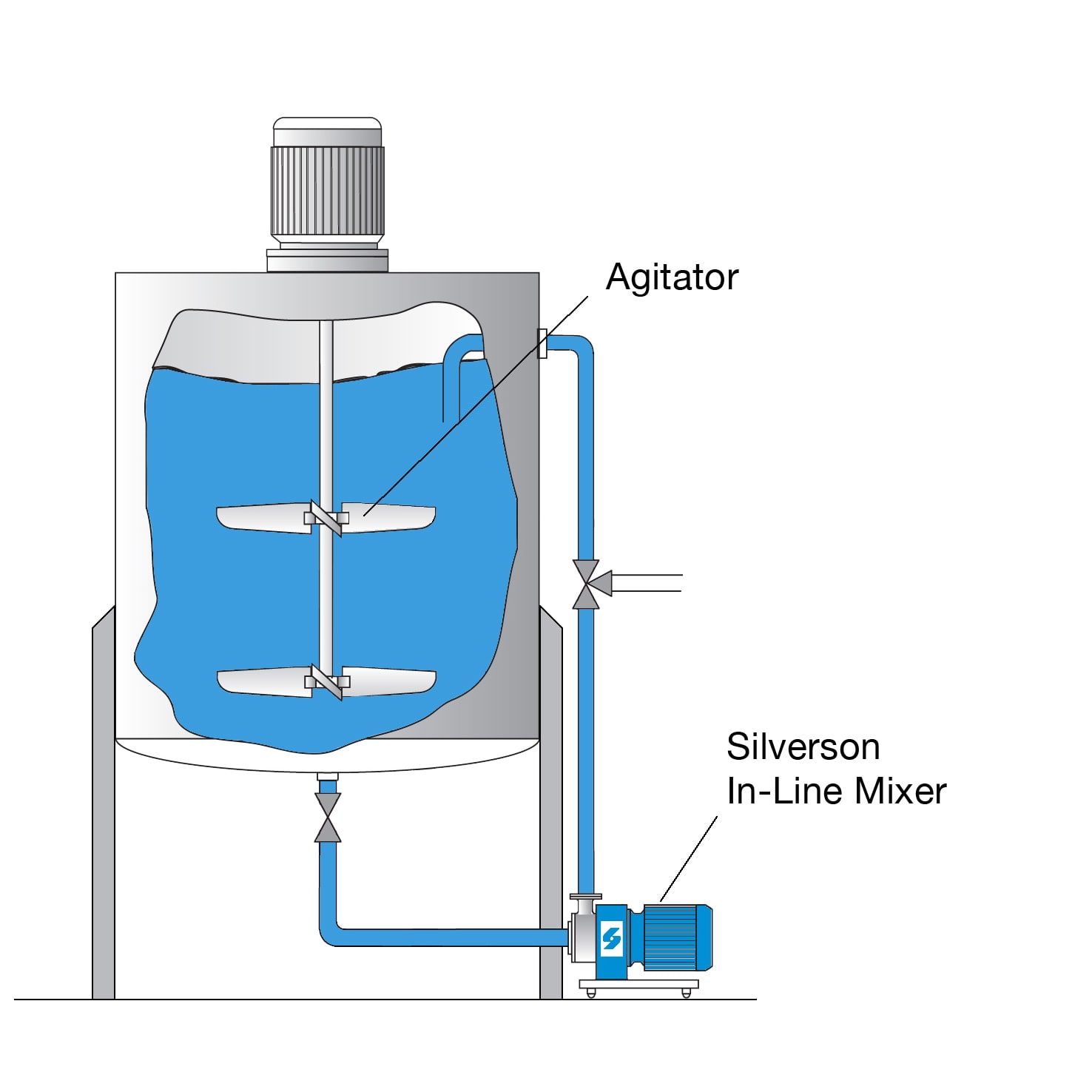
- Polymer pellets or crumbs are added to the hot oil and dispersed by the agitator.
- The In-Line mixer is started. The product is drawn from the base of the vessel into the workhead of the In-Line mixer.
- The polymer is subjected to intense high shear which reduces particle size, exposing an increasing surface area of polymer to the surrounding base oil, accelerating the solubilization process.
- The self-pumping In-Line mixer returns the product to the vessel as fresh material is drawn into the workhead, continuing the mixing cycle.
- Solubilization is completed in a fraction of the time taken by agitation alone.
Crumb & Pellet - Granular Size
A vessel mounted Silverson Duplex Disintegrator Dissolver coupled to a Silverson high shear In-Line mixer can disintegrate and solubilize larger chunks or blocks of polymer.
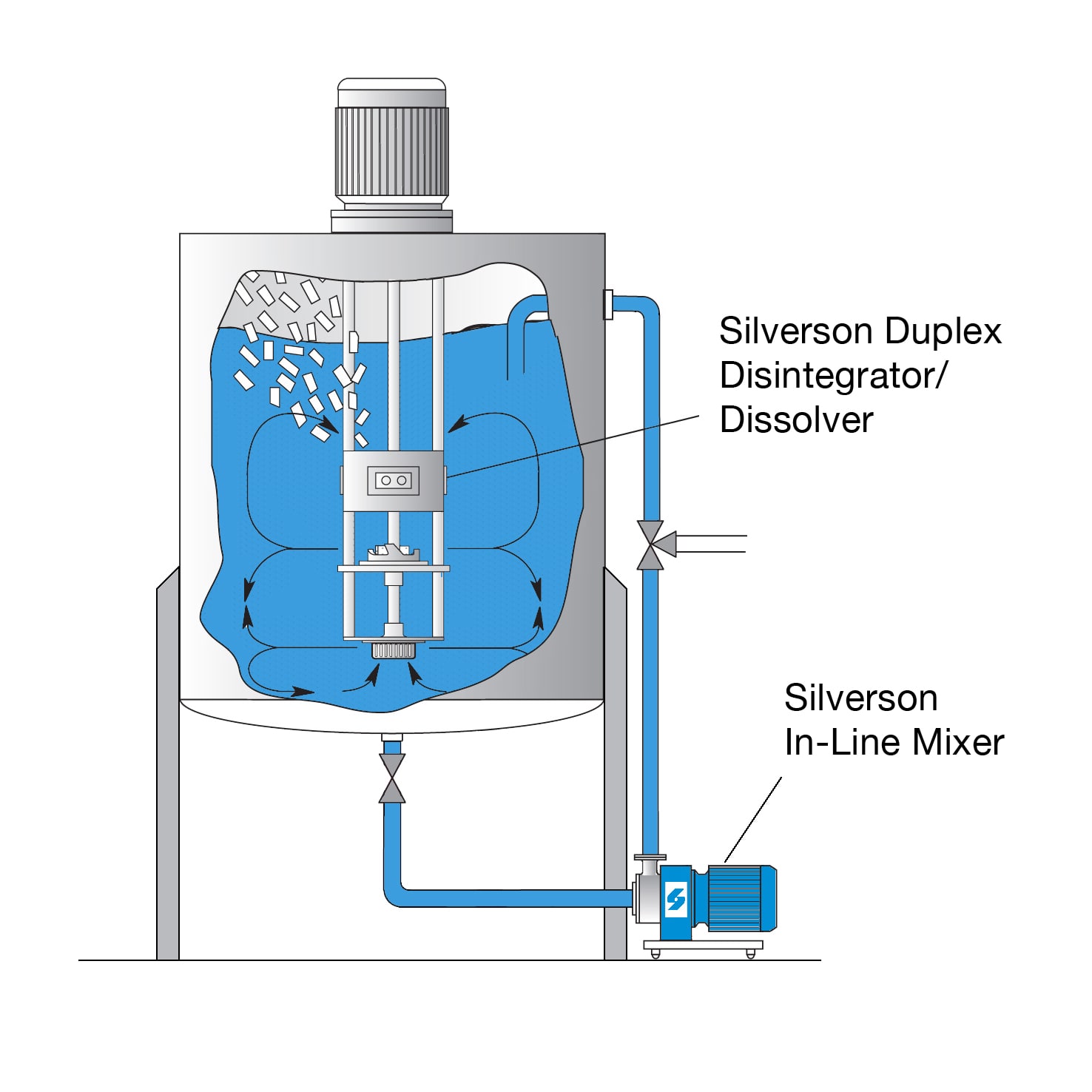
- Polymer blocks up to brick size are added to the hot oil and drawn down into the upper head of the duplex mixer.
- The coarse tooth disintegrating head reduces the polymer blocks to crumb size.
- The lower workhead, fitted with a finer slotted disintegrating head further reduces the particles to granular size.
- The In-Line mixer is started and processes the polymer as described previously.
Solid Bales
Silverson has developed the Disintegrator 2500, a complete system for the solubilization of viscosity index improvers into lube oils. The D2500 consists of a custom built vessel fitted with a powerful high shear disintegrator workhead coupled to a Silverson In-Line mixer. Operation is as follows:

Stage 1
Base oil is pumped into the vessel and heated to appropriate temperature. The Silverson bottom entry mixer is started and the polymer bales are added. The powerful vortex created by the mixer draws the solids down from the surface into the coarse tooth disintegrating head of the mixer which shears off edges and corners of the bales.

Stage 2
The solids are rapidly reduced to smaller pieces which are drawn into the interior of the workhead and subjected to intense shear before being forced out through the stator and back into the surrounding liquid.
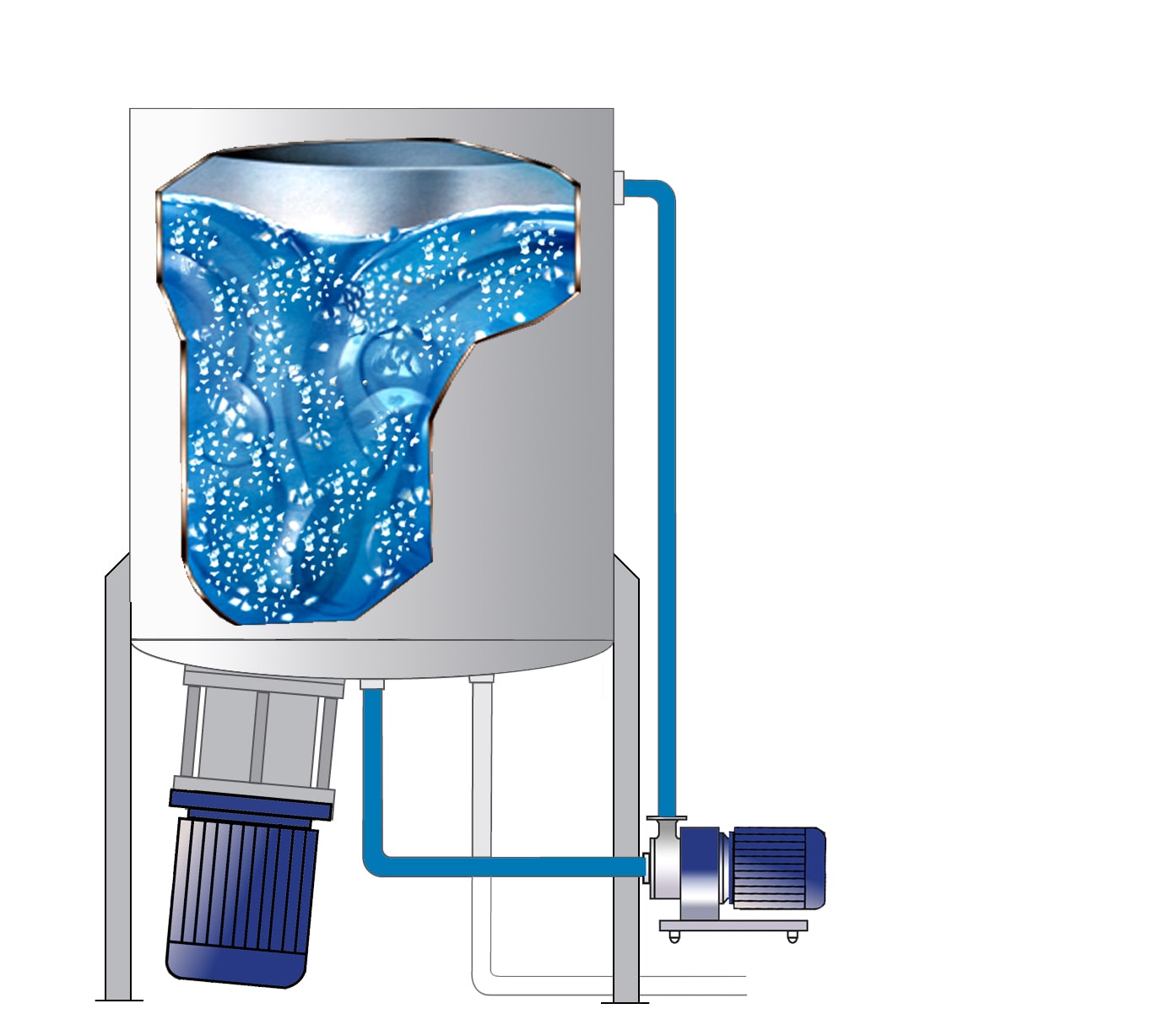
Stage 3
Once the solids have been reduced to granular size the Silverson In-Line mixer is started. The product is drawn from the vessel and processed in the rotor/stator workhead of the In-Line mixer before being returned to the vessel by the self-pumping action of the In-Line mixer.

Stage 4
The intense high shear exerted on the polymer by the bottom entry and In-Line mixers ensures that particle size is minimized, exposing a greater surface area of polymer to the surrounding oil, allowing rapid solubilization to be achieved. Samples can be drawn off to check dispersion and solubilization is complete before the finished product is discharged.
The advantages of the Silverson high shear mixer stem from the three stage mixing/shearing action generated by the precision machined workhead. Operation is as follows:
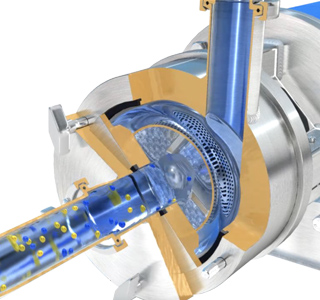
Stage 1
The high speed rotation of the rotor within the workhead creates a powerful suction which draws the base oil and polymer particles into the interior of the workhead. Centrifugal force drives the materials to the periphery of the workhead.
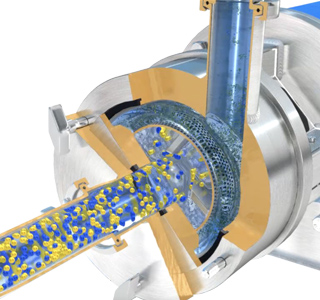
Stage 2
The polymer particles are subjected to a milling action in the gap between the rotor tip and stator wall, reducing particle size. The product is then forced out of the stator at great velocity as fresh material is drawn in.

Stage 3
The entire contents of the vessel passes through the workhead many hundreds of times, progressively reducing the size of the polymer particles. An increasing surface area is exposed to the base oil, accelerating the solubilization process.
-
Stage 1

Stage 1
The high speed rotation of the rotor within the workhead creates a powerful suction which draws the base oil and polymer particles into the interior of the workhead. Centrifugal force drives the materials to the periphery of the workhead.
-
Stage 2

Stage 2
The polymer particles are subjected to a milling action in the gap between the rotor tip and stator wall, reducing particle size. The product is then forced out of the stator at great velocity as fresh material is drawn in.
-
Stage 3

Stage 3
The entire contents of the vessel passes through the workhead many hundreds of times, progressively reducing the size of the polymer particles. An increasing surface area is exposed to the base oil, accelerating the solubilization process.
The Advantages
Crumb & Pellet - Larger Chunks and Blocks
In-Line mixer:
- The rotor/stator workhead rapidly disintegrates the polymer pieces, exposing an increasing surface area of polymer to the base oil.
- The high shear action of the In-Line mixer dramatically reduces processing time.
- Agglomerated particles are instantly disintegrated in the In-Line mixer’s workhead.
- The In-Line mixer concentrates its effort on a relatively small volume within the workhead rather than the entire batch, a more energy efficient process.
- Bypassing the intense high shear action of the rotor/stator assembly is impossible, once the product is in the recirculating line.
- No additional pumping is required to circulated the product back into the tank.
Crumb & Pellet - Granular Size
Duplex Disintegrator Dissolver:
- Shredding or granulating of polymer to a fine particle size is not required. Coarsely chopped polymer can be added to the vessel and finely disintegrated by the Duplex mixer. This greatly reduces overall processing times.
- Dramatically reduced solubilizing times.
- Nitrogen blanketing can be eliminated as shorter processing time reduces possibility of oxidation and discoloration.
- Vigorous in-tank agitation ensures particles do not re-agglomerate.
- Cleaner working conditions.
- The entire operation is carried out in a single vessel.
Solid Bales
- Polymer bales, blocks or pieces of any shape and size, even the largest commercially available, can be added directly to the vessel.
- Pre-grinding, shredding or chopping of polymer is eliminated.
- Dramatically reduced processing times.
- Nitrogen blanketing can be eliminated as shorter processing time reduces oxidation and discoloration.
- Vigorous in-tank agitation ensures particles are de-agglomerated and no build-up of material on the vessel wall occurs, improving the yield of polymer.
- Cleaner working conditions.
- The entire operation is carried out in a single vessel.